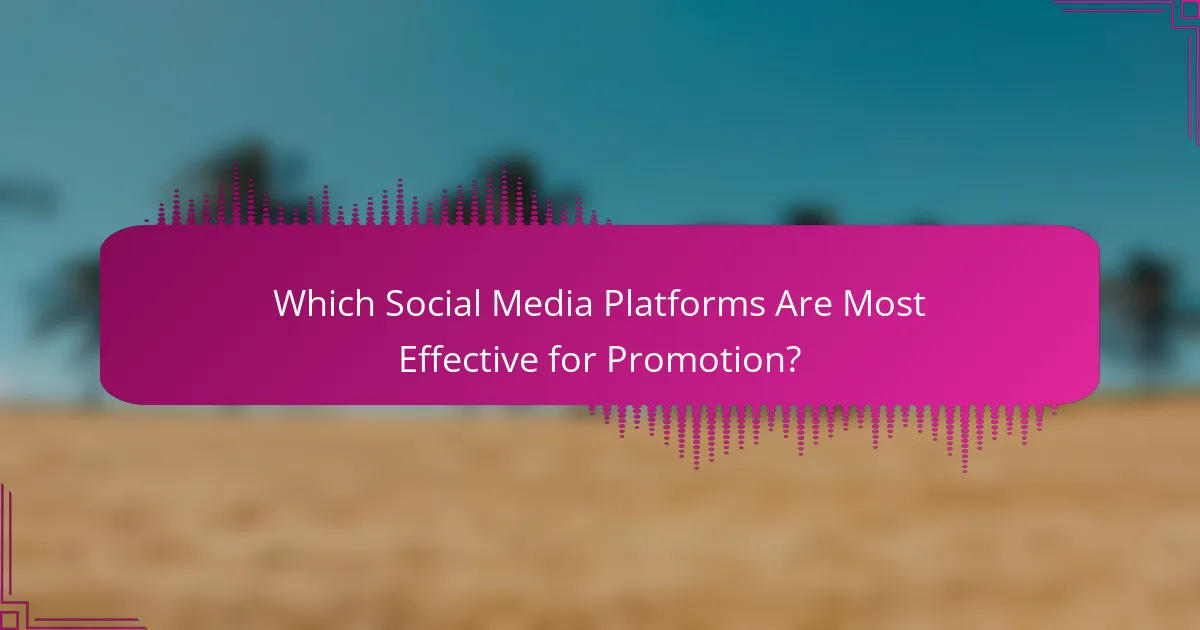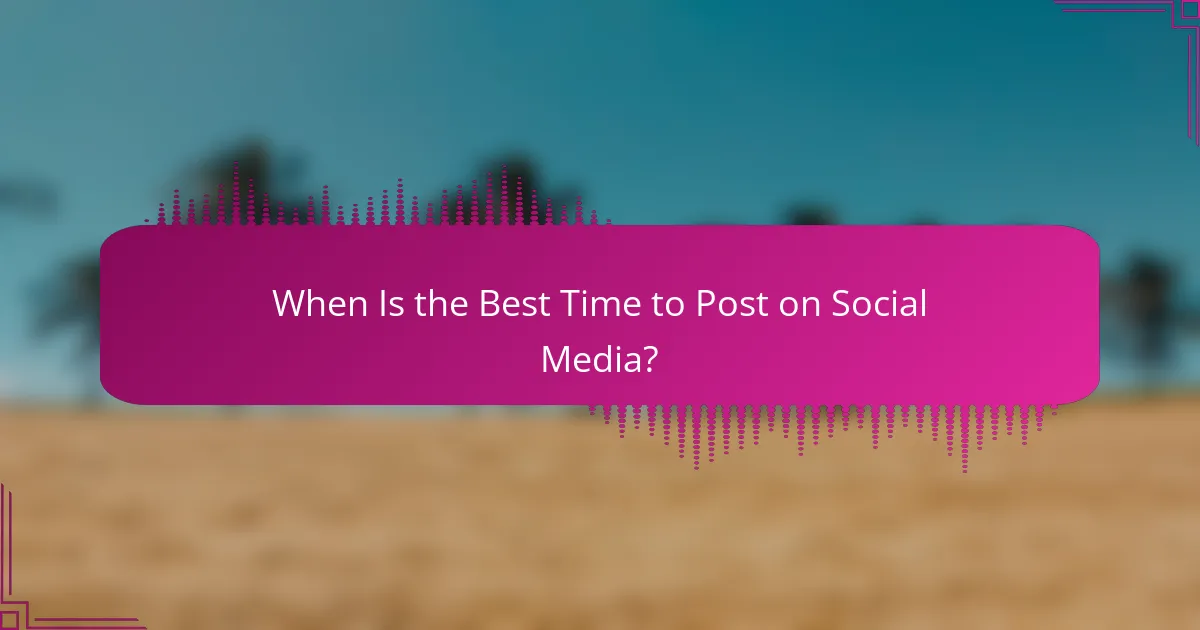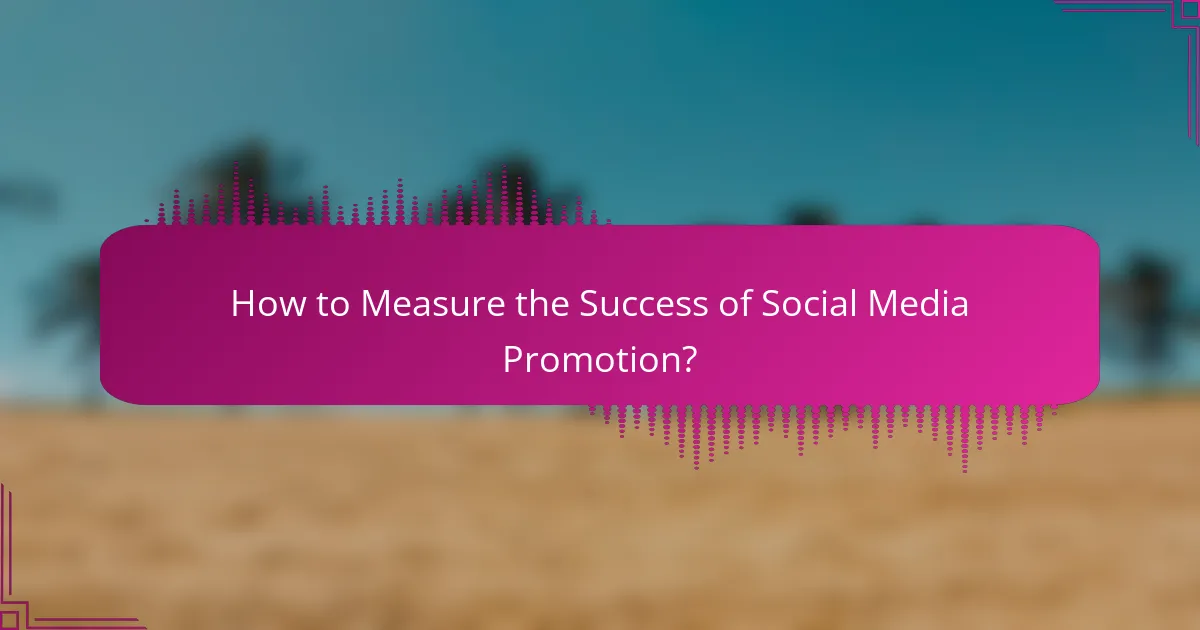Social media promotion is essential for reaching your target audience and achieving marketing goals, with platforms like Facebook, Instagram, LinkedIn, Twitter, and TikTok each offering distinct advantages. To maximize effectiveness, a combination of strategies such as content marketing, influencer partnerships, and paid advertising should be employed. Additionally, timing your posts to align with your audience’s online habits can significantly enhance engagement and visibility.

Which Social Media Platforms Are Most Effective for Promotion?
The most effective social media platforms for promotion vary based on target audience and marketing goals. Key platforms include Facebook, Instagram, LinkedIn, Twitter, and TikTok, each offering unique advantages for different types of engagement and outreach.
Facebook for broad reach
Facebook is ideal for reaching a diverse audience due to its extensive user base. With billions of active users, businesses can utilize targeted ads to connect with specific demographics based on interests, behaviors, and location.
To maximize effectiveness, consider using Facebook Groups to foster community engagement and share valuable content. Regularly posting updates and interacting with followers can enhance brand loyalty.
Instagram for visual engagement
Instagram excels in visual storytelling, making it perfect for brands that rely on aesthetics. High-quality images and videos can capture attention and drive engagement, particularly among younger audiences.
Utilizing features like Stories and Reels can increase visibility and interaction. Brands should maintain a consistent visual style and use relevant hashtags to reach a broader audience.
LinkedIn for B2B networking
LinkedIn is the go-to platform for B2B marketing and professional networking. It allows businesses to connect with industry professionals, share insights, and showcase expertise through articles and posts.
To leverage LinkedIn effectively, companies should engage in group discussions and share valuable content that addresses industry challenges. Building a strong professional network can lead to valuable partnerships and opportunities.
Twitter for real-time interaction
Twitter is known for its fast-paced environment, making it suitable for real-time interaction and updates. Brands can engage with their audience through tweets, retweets, and replies, fostering immediate conversations.
Utilizing trending hashtags can increase visibility, while regular posting helps maintain relevance. Brands should be prepared to respond quickly to inquiries or comments to enhance customer relations.
TikTok for younger audiences
TikTok is rapidly gaining popularity among younger demographics, making it a powerful platform for brands targeting Gen Z and millennials. Creative and entertaining short videos can effectively capture attention and drive engagement.
Brands should focus on authentic content that resonates with users, often leveraging trends and challenges. Collaborating with influencers can also amplify reach and credibility within this audience segment.

What Strategies Enhance Social Media Promotion?
Effective social media promotion relies on a combination of strategies that boost visibility, engagement, and conversion rates. Key approaches include content marketing, influencer partnerships, paid advertising, and community building.
Content marketing strategies
Content marketing strategies involve creating and sharing valuable content to attract and engage your target audience. This can include blog posts, videos, infographics, and social media updates that resonate with your followers.
To maximize impact, focus on quality over quantity. Aim for a consistent posting schedule, ideally several times a week, and tailor your content to the preferences of your audience. Use analytics tools to track engagement and adjust your strategy accordingly.
Influencer partnerships
Influencer partnerships leverage the reach and credibility of individuals with a significant following on social media. Collaborating with influencers can help promote your brand to a wider audience and build trust.
When selecting influencers, consider their relevance to your niche and audience demographics. Establish clear goals for the partnership, whether it’s brand awareness or direct sales, and ensure that the content aligns with your brand values.
Paid advertising options
Paid advertising options on social media platforms allow for targeted promotion to specific demographics. This includes sponsored posts, pay-per-click ads, and boosted content that can increase visibility and engagement.
Set a budget that aligns with your marketing goals and choose platforms where your audience is most active. Monitor ad performance regularly and be prepared to adjust your strategy based on what works best, whether that’s changing visuals, copy, or targeting parameters.
Engagement through community building
Engagement through community building focuses on fostering relationships with your audience. This can be achieved by creating groups, hosting live events, or encouraging user-generated content.
Encourage interaction by asking questions, responding to comments, and recognizing loyal followers. Building a strong community can lead to increased brand loyalty and organic promotion as satisfied customers share their experiences.

When Is the Best Time to Post on Social Media?
The best time to post on social media varies by platform and audience but generally falls during weekdays and evenings. Understanding your target audience’s habits can significantly enhance engagement and reach.
Weekdays for professional content
Weekdays, particularly Tuesday through Thursday, are optimal for sharing professional content on platforms like LinkedIn. Many professionals engage with content during work hours, typically between 10 AM and 2 PM, when they are more likely to be online and receptive.
To maximize visibility, consider posting during lunch breaks or mid-afternoon slumps. Avoid Mondays, as people are often catching up on work, and Fridays, when attention shifts towards the weekend.
Evenings for consumer engagement
Evenings are ideal for consumer-focused posts, especially on platforms like Facebook and Instagram. Engagement peaks around 7 PM to 9 PM, as users unwind and browse their feeds after work.
Consider using this time to share promotional content, product launches, or interactive posts. Weekends can also be effective, particularly for lifestyle brands, but aim for late mornings or early afternoons to capture weekend traffic.
Seasonal trends impacting timing
Seasonal trends can greatly influence the timing of your social media posts. For instance, holiday seasons often see increased online activity, making it a prime time for promotions and festive content.
Monitor trends related to your industry; for example, retail brands may benefit from posting around Black Friday or back-to-school periods. Adjust your posting schedule to align with these peak times to capitalize on heightened consumer interest.

How to Measure the Success of Social Media Promotion?
Measuring the success of social media promotion involves analyzing various metrics that reflect engagement, conversions, and overall return on investment (ROI). By focusing on these key areas, businesses can determine the effectiveness of their social media strategies and make informed adjustments.
Engagement metrics analysis
Engagement metrics include likes, shares, comments, and overall interactions with your content. These indicators help assess how well your audience resonates with your posts and can guide content strategy adjustments. For instance, a post with high engagement may suggest that similar content could be beneficial in the future.
To analyze engagement effectively, track these metrics over time and compare them across different platforms. Tools like Google Analytics or social media insights can provide valuable data. Aim for a consistent increase in engagement rates, which typically range from 1% to 5% for most industries.
Conversion tracking
Conversion tracking measures how many users take a desired action after engaging with your social media content, such as making a purchase or signing up for a newsletter. This metric is crucial for understanding the direct impact of your promotions. Set up tracking pixels or use UTM parameters to monitor conversions accurately.
Consider using tools like Facebook Pixel or Google Tag Manager to streamline this process. A good conversion rate varies by industry but often falls between 2% and 10%. Regularly review these rates to identify successful campaigns and areas needing improvement.
ROI calculations
Calculating ROI for social media promotions involves comparing the revenue generated from your campaigns against the costs incurred. This calculation can help determine the financial effectiveness of your social media efforts. The basic formula is (Net Profit / Cost of Investment) x 100.
For example, if you spent $1,000 on a campaign and generated $5,000 in sales, your ROI would be 400%. Aim for a positive ROI, ideally above 100%, to ensure your social media strategies are financially viable. Regularly assess and adjust your campaigns based on these calculations to maximize profitability.

What Are the Key Considerations for Social Media Advertising?
Key considerations for social media advertising include understanding your target audience, effectively allocating your budget, and timing your campaigns for maximum impact. Each aspect plays a crucial role in ensuring your advertising efforts yield the best possible results.
Target audience identification
Identifying your target audience is essential for successful social media advertising. This involves researching demographics, interests, and online behaviors to tailor your content and messaging effectively. Utilize tools like Facebook Insights or Twitter Analytics to gather data on your audience.
Consider creating audience personas that represent segments of your target market. These personas can help guide your content creation and advertising strategies, ensuring that you address the specific needs and preferences of different groups.
Budget allocation strategies
Effective budget allocation is vital for maximizing the return on your social media advertising investment. Start by determining your overall marketing budget and then decide what percentage to allocate to social media. A common approach is to allocate around 10-20% of your total marketing budget to social media efforts.
When allocating your budget, consider the platforms that yield the best results for your audience. For instance, if your target demographic is primarily on Instagram, prioritize your spending there. Regularly review and adjust your budget based on campaign performance to ensure optimal use of funds.
